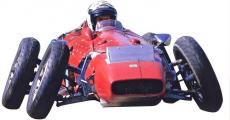Swing axles defended…
 I’d no sooner finished writing A Disappearing Suspension Technology than I came across something that goes a long way to explaining the reason that swing-arm suspension was used by such hugely respected engineers like Porsche and by companies like Mercedes.
I’d no sooner finished writing A Disappearing Suspension Technology than I came across something that goes a long way to explaining the reason that swing-arm suspension was used by such hugely respected engineers like Porsche and by companies like Mercedes.
The magazine article is on a very interesting car produced by one of the all-time greats in suspension theory. The designer of the car was Bill Milliken and the premise was that by using narrow tyres running a huge amount of negative camber, very good cornering grip would be able to be obtained.
Now there’s a lot more to his car than just that (by clicking on the magnifying glass you can enlarge the article scans enough to print/read them) but the narrow tyres/huge neg camber is a very short summary.
The tyres being used by Auto Union and Mercedes pre-WWII race cars were similar in width to current big motorcycle tyres and so would have been far less susceptible to loss of grip through lifting of the flat tread of the tyre that would otherwise occur through negative camber. In fact, the lateral thrust from the camber achieved by the swing-arms would, as the Milliken car shows, have made a major contribution to cornering grip.
It makes me think that a lightweight car running low pivot point swing-arm (or semi-trailing or leading) suspension and motorcycle tyres could develop a lot of grip while maintaining an ultra lightweight suspension, in turn giving a very low unsprung weight and low total vehicle mass. And the narrow wheels and tyres would also give far lower rotating inertia, improving acceleration and braking still further…

 Julian Edgar, 50, has been writing about car modification and automotive technology for nearly 25 years. He has owned cars with two, three, four, five, six and eight cylinders; single turbo, twin turbo, supercharged, diesel and hybrid electric drivelines. He lists his transport interests as turbocharging, aerodynamics, suspension design and human-powered vehicles.
Julian Edgar, 50, has been writing about car modification and automotive technology for nearly 25 years. He has owned cars with two, three, four, five, six and eight cylinders; single turbo, twin turbo, supercharged, diesel and hybrid electric drivelines. He lists his transport interests as turbocharging, aerodynamics, suspension design and human-powered vehicles.

on July 25th, 2007 at 7:49 pm
On a similar note (long gone suspension technology), what is wrong with using a live axle or de-dion suspension on today’s ultra-smooth racetracks? Camber change when one wheel goes over a bump would not happen often enough to worry about (excluding driver error causing off-track excursions), and the wheels would stay at thier designated camber settings (relative to the road) during braking and cornering conditions. I think that the recent upper control arm change on the Autospeed EF shows what getting the angles right can achieve on a live axle. Your thoughts people?
on July 26th, 2007 at 2:17 am
Current F1 cars, in order to cope with aero downforce, are so stiifly sprung they effectively have solid axles.
on July 29th, 2007 at 5:05 am
I think the most gain to be had in reducing unsprung weight is in the wheels and brakes. An average brake and wheel assembly would have to weigh a good 20kg I would’ve thought (wild guess there…) and with big mags, especially thick spoked ones, or with bigger aftermarket brakes, the weight goes up very quickly.
Magnesium wheels and ceramic rotors would achieve a better weight saving than going from say a MacPherson Strut assy to a swing axle. The only problem is of course the cost involved, especially in the ceramic rotors. I think it’s a $40,000 option for Porsches just for the ceramic rotors…Big money!
Ben, talking about unsprung weight, there’s a lot of weight in a diff. With semi or fully independant suspension, the diff is fixed to the chassis, greatly reducing unsprung weight. As for ultra smooth race tracks, they’re few and far between still. Especially in Australia. A lot of them have been resurfaced, but most of the bumps remain, just with that nice blacktop stuff on top instead of harsh bitumen. =)
on August 13th, 2007 at 9:13 am
With de-dion suspension, an unsprung diff housing is not needed. All it is (from my understanding) is a normal independant suspension, with an expandable link between the hubs to keep the camber between each wheel (and the road) the same. The chassis mounted diff remains, as does the wheels tendency to move further apart on compression of the suspension (if the arms are set up like that). I imagine that if the link were strong enough only one chassis-hub arm would be needed per corner, compensating partly for the weight of the wheel-wheel link.
I’ll wear the comment about the lack of smooth tracks though.
on December 20th, 2008 at 3:00 am
While the swing axle was never ideal, it was vastly better than the beam axle.
Sure the wheel motion is not as ideal as dis-simarlar A arms, but it requires far less parts and provides far stiffer wheel location for the same wieght.
Hence in racing where the weight to strength ratio are so important, swing axle designs were often chosen.
I still use it’s sister the semi-trailing arm, very easy to ‘homebrew’ out of tube,
light, simple, works plenty well enough.